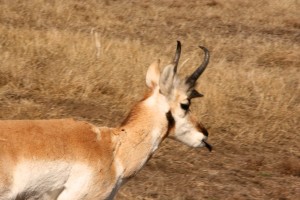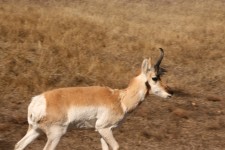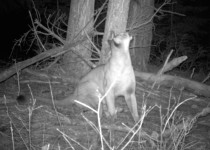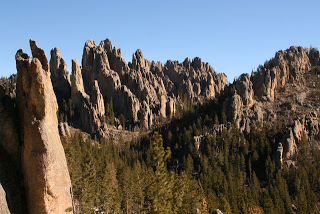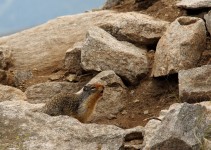Capable of bursts of speed greater than 60 miles per hour and sustained speeds of 45 mph, the pronghorn gracefully speeds across the American Plains and grasslands across the West.
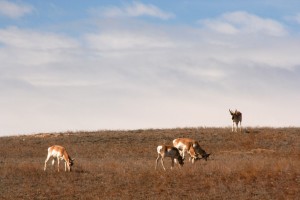
Pronghorns stand two-and-a-half to three-and-a-half feet tall at the shoulders and range from 75 to 140 pounds
If a pronghorn and a cheetah raced, the cheetah would win the sprint and the pronghorn would win the marathon.
Pronghorns are built for speed and endurance because they were once hunted by American cheetahs, lions and saber-toothed cats. Now the pronghorn’s main predator is coyotes and coyotes usually only prey on the young. Bobcats and golden eagles also prey on young. Healthy adults are rarely killed by predators.
With an enlarged heart and windpipes, oxygen virtually pours into the pronghorn’s blood and muscles. The large quantities of oxygen fuel the pronghorn so it can cross the length of a football field in 3.5 seconds with only 10 strides.
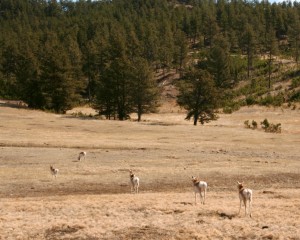
Pronghorns raise the hairs on their white rumps to warn others of danger just as white-tailed deer show their white tail
Football fields are smooth but the grasslands and shrubby areas that pronghorns inhabit are not smooth. A pronghorn’s leg bones are twice as thick as a cow’s leg bones which enables them to run over rough terrain without breaking their legs. Their long pointed toes are also cushioned to help absorb the shock of running.
Not only do pronghorns easily outrun predators but they usually spot them before they even come remotely close. With protruding eyes the size of a horse’s eye, pronghorns can see something moving up to four miles away in their nearly 360 degree field of vision. However, the object needs to be moving to be seen.
Pronghorns, like deer, also warn each other of impending danger. When alarmed pronghorns fan their white rump hairs and emit a chemical odor from glands within the white patch to warn others. They also make an explosive snort and stamp their foot like white-tailed deer.
When a herd of pronghorns flees a predator they spread into an ellipse pattern with the dominant female leading. Amazingly, pronghorns synchronize their gait, speed and even which foot leads. The synchronization of the herd makes it harder for a predator to pick out one individual to prey upon.
While pronghorns share many similarities with other ungulates, such as white-tailed deer, they are in a family all by themselves (Antilocapridae) because they sport a cross between antlers and horns.
Pronghorns, as their name implies, have pronged horns while animals with true horns only have one point. The unique aspect of their horns is they shed the black sheath covering them each year. The bony core is retained like in other animal’s horns and increases in size each year.
However, the growth of the new sheath pushes off the old sheath each year. Males tend to shed the sheaths one month after rut and females typically shed their sheaths in the summer.
The horns of the male and female differ. Males have the pronged horn with one prong jutting forward and the branch angling backwards. Females sport a short four- to six-inch simple horn with one point.
While pronghorns are called antelope, they are not the same as the antelope in Africa. Instead they are their own unique family that gallops amazingly fast across the American Plains without a cheetah in pursuit.

